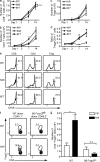Targeting of B and T lymphocyte associated (BTLA) prevents graft-versus-host disease without global immunosuppression
- PMID: 21078889
- PMCID: PMC2989771
- DOI: 10.1084/jem.20102017
Targeting of B and T lymphocyte associated (BTLA) prevents graft-versus-host disease without global immunosuppression
Abstract
Graft-versus-host disease (GVHD) causes significant morbidity and mortality in allogeneic hematopoietic stem cell transplantation (aHSCT), preventing its broader application to non-life-threatening diseases. We show that a single administration of a nondepleting monoclonal antibody specific for the coinhibitory immunoglobulin receptor, B and T lymphocyte associated (BTLA), permanently prevented GVHD when administered at the time of aHSCT. Once GVHD was established, anti-BTLA treatment was unable to reverse disease, suggesting that its mechanism occurs early after aHSCT. Anti-BTLA treatment prevented GVHD independently of its ligand, the costimulatory tumor necrosis factor receptor herpesvirus entry mediator (HVEM), and required BTLA expression by donor-derived T cells. Furthermore, anti-BTLA treatment led to the relative inhibition of CD4(+) forkhead box P3(-) (Foxp3(-)) effector T cell (T eff cell) expansion compared with precommitted naturally occurring donor-derived CD4(+) Foxp3(+) regulatory T cell (T reg cell) and allowed for graft-versus-tumor (GVT) effects as well as robust responses to pathogens. These results suggest that BTLA agonism rebalances T cell expansion in lymphopenic hosts after aHSCT, thereby preventing GVHD without global immunosuppression. Thus, targeting BTLA with a monoclonal antibody at the initiation of aHSCT therapy might reduce limitations imposed by histocompatibility and allow broader application to treatment of non-life-threatening diseases.
Figures




Similar articles
-
B- and T-lymphocyte attenuator targeting protects against the acute phase of graft versus host reaction by inhibiting donor anti-host cytotoxicity.Transplantation. 2011 Nov 27;92(10):1085-93. doi: 10.1097/TP.0b013e3182339d4a. Transplantation. 2011. PMID: 21978997
-
Dichotomous regulation of GVHD through bidirectional functions of the BTLA-HVEM pathway.Blood. 2011 Feb 24;117(8):2506-14. doi: 10.1182/blood-2010-08-301325. Epub 2011 Jan 10. Blood. 2011. PMID: 21220749 Free PMC article.
-
B and T lymphocyte attenuator mediates inhibition of tumor-reactive CD8+ T cells in patients after allogeneic stem cell transplantation.J Immunol. 2012 Jul 1;189(1):39-49. doi: 10.4049/jimmunol.1102807. Epub 2012 May 25. J Immunol. 2012. PMID: 22634623
-
Alloreactivity as therapeutic principle in the treatment of hematologic malignancies. Studies of clinical and immunologic aspects of allogeneic hematopoietic cell transplantation with nonmyeloablative conditioning.Dan Med Bull. 2007 May;54(2):112-39. Dan Med Bull. 2007. PMID: 17521527 Review.
-
BTLA and HVEM cross talk regulates inhibition and costimulation.Adv Immunol. 2006;92:157-85. doi: 10.1016/S0065-2776(06)92004-5. Adv Immunol. 2006. PMID: 17145304 Review.
Cited by
-
BTLA agonist attenuates Th17-driven inflammation in a mouse model of steroid-resistant asthma.Front Immunol. 2025 Mar 28;16:1552394. doi: 10.3389/fimmu.2025.1552394. eCollection 2025. Front Immunol. 2025. PMID: 40226621 Free PMC article.
-
Btla signaling in conventional and regulatory lymphocytes coordinately tempers humoral immunity in the intestinal mucosa.Cell Rep. 2022 Mar 22;38(12):110553. doi: 10.1016/j.celrep.2022.110553. Cell Rep. 2022. PMID: 35320716 Free PMC article.
-
Comparison of antibody-based immunotherapeutics for malignant hematological disease in an experimental murine model.Blood Adv. 2024 Apr 23;8(8):1934-1945. doi: 10.1182/bloodadvances.2023011647. Blood Adv. 2024. PMID: 38197968 Free PMC article.
-
Roles of BTLA in Immunity and Immune Disorders.Front Immunol. 2021 Mar 29;12:654960. doi: 10.3389/fimmu.2021.654960. eCollection 2021. Front Immunol. 2021. PMID: 33859648 Free PMC article. Review.
-
Advances in targeting cell surface signalling molecules for immune modulation.Nat Rev Drug Discov. 2013 Feb;12(2):130-46. doi: 10.1038/nrd3877. Nat Rev Drug Discov. 2013. PMID: 23370250 Free PMC article. Review.
References
-
- Blazar B.R., Carreno B.M., Panoskaltsis-Mortari A., Carter L., Iwai Y., Yagita H., Nishimura H., Taylor P.A. 2003. Blockade of programmed death-1 engagement accelerates graft-versus-host disease lethality by an IFN-gamma-dependent mechanism. J. Immunol. 171:1272–1277 - PubMed
-
- Cooke K.R., Kobzik L., Martin T.R., Brewer J., Delmonte J., Jr, Crawford J.M., Ferrara J.L.M. 1996. An experimental model of idiopathic pneumonia syndrome after bone marrow transplantation: I. The roles of minor H antigens and endotoxin. Blood. 88:3230–3239 - PubMed
Publication types
MeSH terms
Substances
Grants and funding
LinkOut - more resources
Full Text Sources
Other Literature Sources
Research Materials

